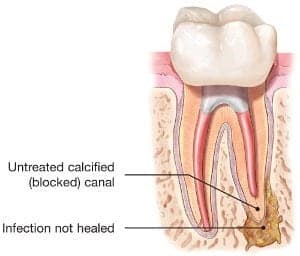Root Canal Treatment
What is Root Canal Treatment (Endodontics)?
Root canal treatment is one of the most common dental procedures performed. This simple treatment can save your natural teeth and prevent the need for dental implants or bridges. At the center of your tooth is a canal filled with pulp. A pulp is a collection of blood vessels and nerves that keep the tooth alive. Infection of the pulp can be caused by trauma to the tooth, deep decay, cracks and chips, or repeated dental procedures. Symptoms of the infection can be identified as visible injury or swelling of the tooth, sensitivity to temperature, or pain in the tooth and gums.
How do you know if you need a root canal therapy?
Root canals therapies are needed for a cracked tooth from injury or genetics, a deep cavity, or issues from a previous filling. Patients generally need a root canal when they notice their teeth are sensitive, particularly to hot and cold sensations.
There are a few symptoms that mean you might need a root canal therapy.
- Severe pain while chewing or biting
- Pimples on the gums
- A chipped or cracked tooth
- lingering sensitivity to hot or cold, even after the sensation has been removed.
- Swollen or tender gums
- Deep decay or darkening of the gums
How long does a root canal therapy take?
The length of time a root canal takes typically varies on two factors: how many roots your tooth has and how bad the infection is.
Typically, a root canal procedure requires one or two visits. Each visit can vary from 30 to 90 minutes on average.
Here’s a quick rundown on the average time it takes for each tooth:
- Molars, 90 minutes or more. Molars are located in the back of your mouth and have up to four roots.
- Premolars: 60 minutes. Premolars are in between your molars and anterior teeth and have one or two roots.
- Canines and incisors: 45 to 60 minutes. These teeth have only one root.
If your tooth needs a dental crown, that’ll require more time, which may take up to 60 minutes. Often, this step will require another appointment, allowing time to guarantee your tooth has healed before the crown is permanently placed.

How painful is a root canal therapy?
A root canal therapy is a major dental procedure. So you may experience some slight discomfort, just as you would with a dental filling.
However, it shouldn’t be painful. A general anesthetic will keep your teeth and surrounding area numb throughout the whole procedure.
As the anesthetic wears off when you get home, you may feel some discomfort. You can manage the pain with over-the-counter pain medications like Advil.
The real pain comes from not getting it treated
An untreated infected tooth can result in excruciating pain and result in an emergency root canal, which is way more costly.
Many patients who were in pain before treatment claim that the procedure actually provided them with pain relief.
Endodontic Retreatment Explained
With proper care, even teeth that have had root canal treatment can last a lifetime. But sometimes, a tooth that has been treated doesn't heal properly and can become painful or diseased months or even years after treatment. If your tooth fails to heal or develops new problems, you have a second chance. An additional procedure may be able to support healing and save your tooth. If you have pain or discomfort in a previously treated tooth, talk to an endodontist about retreatment.
Why do I need another endodontic procedure?
As occasionally happens with any dental or medical procedure, a tooth may not heal as expected after initial treatment for a variety of reasons:
- Narrow or curved canals were not treated during the initial procedure.
- Complicated canal anatomy went undetected in the first procedure.
- The placement of the crown or other restoration was delayed following the endodontic treatment.
- The restoration did not prevent salivary contamination of the inside of the tooth.
In other cases, a new problem can jeopardize a tooth that has been successfully treated.
For example:
- New decay can expose the root canal filling material to bacteria, causing a new infection in the tooth.
- A crown or filling that is loose, cracked, or broken can expose the tooth to new infection.
- A tooth sustains a fracture.




